-
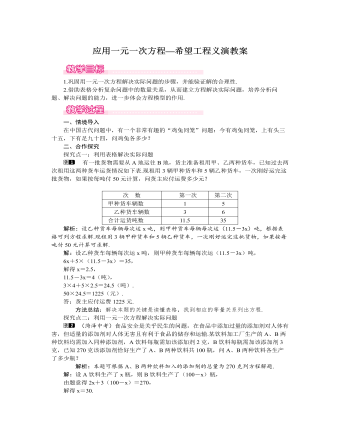
北师大初中七年级数学上册应用一元一次方程——“希望工程”义演教案1
方法总结:解题关键是要读懂题目的意思,根据题目给出的条件,找出合适的等量关系,列出方程再求解.探究点三:工程问题一个道路工程,甲队单独施工9天完成,乙队单独做24天完成.现在甲乙两队共同施工3天,因甲另有任务,剩下的工程由乙队完成,问乙队还需几天才能完成?解析:首先设乙队还需x天才能完成,由题意可得等量关系:甲队干三天的工作量+乙队干(x+3)天的工作量=1,根据等量关系列出方程,求解即可.解:设乙队还需x天才能完成,由题意得:19×3+124(3+x)=1,解得:x=13.答:乙队还需13天才能完成.方法总结:找到等量关系是解决问题的关键.本题主要考查的等量关系为:工作效率×工作时间=工作总量,当题中没有一些必须的量时,为了简便,应设其为1.三、板书设计“希望工程”义演题目特点:未知数一般有两个,等量关系也有两个解题思路:利用其中一个等量关系设未知数,利用另一个等量关系列方程
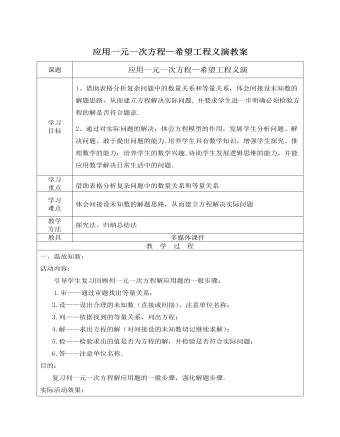
北师大初中七年级数学上册应用一元一次方程——“希望工程”义演教案2
1:甲、乙、丙三个村庄合修一条水渠,计划需要176个劳动力,由于各村人口数不等,只有按2:3:6的比例摊派才较合理,则三个村庄各派多少个劳动力?2:某校组织活动,共有100人参加,要把参加活动的人分成两组,已知第一组人数比第二组人数的2倍少8人,问这两组人数各有多少人?目的:检测学生本节课掌握知识点的情况,及时反馈学生学习中存在的问题.实际活动效果:从学生做题的情况看,大部分学生都能正确地列出方程,但其中一部分人并不能有意识地用“列表格”法来分析问题,因此,教师仍需引导他们能学会用“列表格”这个工具,有利于以后遇上复杂问题能很灵活地得到解决.六、归纳总结:活动内容:学生归纳总结本节课所学知识:1. 两个未知量,两个等量关系,如何列方程;2. 寻找中间量;3. 学会用表格分析数量间的关系.
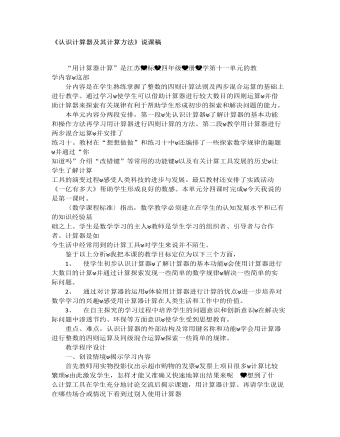
小学数学人教版四年级上册《认识计算器及其计算方法》说课稿
“用计算器计算”是江苏国标版四年级上册数学第十一单元的教学内容这部分内容是在学生熟练掌握了整数的四则计算法则及两步混合运算的基础上进行教学。通过学习使学生可以借助计算器进行较大数目的四则运算并借助计算器来探索有关规律有利于帮助学生形成初步的探索和解决问题的能力。 本单元内容分两段安排,第一段先认识计算器了解计算器的基本功能和操作方法再学习用计算器进行四则计算的方法。第二段教学用计算器进行两步混合运算并安排了练习十。教材在“想想做做”和练习十中还编排了一些探索数学规律的趣题并通过“你知道吗”介绍“改错键”等常用的功能键以及有关计算工具发展的历史让学生了解计算工具的演变过程感受人类科技的进步与发展。最后教材还安排了实践活动《一亿有多大》帮助学生形成良好的数感。本单元分四课时完成今天我说的是第一课时。
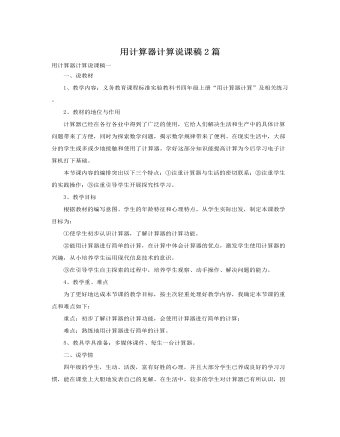
人教版新课标小学数学四年级上册用计算器计算说课稿2篇
请学生先用计算器求出各题的积,然后观察各题中相乘的两个数及所得的积,自主探索和发现积的变化规律。最后进行全班交流,教师做适当总结:这几道算式第一个乘数都是142857,第二个乘数分别是1、2、3、4、5、6,它们的得数与第一个乘数一样,都是由1、2、4、5、7、8这六个数字组成的六位数,不过各个数字所在的数位不同,但如果把这个六位数的乘数按顺时针方向排列在一个圆面上,可以发现这六个积里各数字的排列顺序是一样的,只不过起点不同:乘1的积是从最小的数“1”开始,乘2的积是从第二小的数字“2”开始,乘3的积是从第三小的数字“4”开始……,乘6的积是从最大的数字“8”开始。(2)再出示“想想做做”的第4题先出示:1×1=
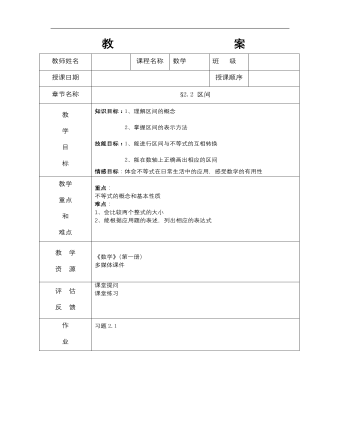
【高教版】中职数学基础模块上册:2.2《区间》教案设计
教师姓名 课程名称数学班 级 授课日期 授课顺序 章节名称§2.2 区间教 学 目 标知识目标:1、理解区间的概念 2、掌握区间的表示方法 技能目标:1、能进行区间与不等式的互相转换 2、能在数轴上正确画出相应的区间 情感目标:体会不等式在日常生活中的应用,感受数学的有用性教学 重点 和 难点 重点: 不等式的概念和基本性质 难点: 1、会比较两个整式的大小 2、能根据应用题的表述,列出相应的表达式教 学 资 源《数学》(第一册) 多媒体课件评 估 反 馈课堂提问 课堂练习作 业习题2.1
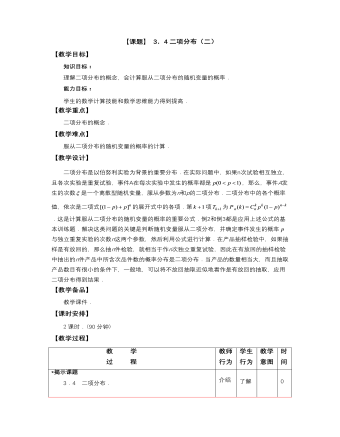
【高教版】中职数学拓展模块:3.4《二项分布》教案设计
教 学 过 程教师 行为学生 行为教学 意图时间 *揭示课题 3.4 二项分布. *创设情境 兴趣导入 我们来看一个问题:从100件产品中有3件不合格品,每次抽取一件有放回地抽取三次,抽到不合格品的次数用表示,求离散型随机变量的概率分布. 由于是有放回的抽取,所以这种抽取是是独立的重复试验.随机变量的所有取值为:0,1,2,3.显然,对于一次抽取,抽到不合格品的概率为0.03,抽到合格品的概率为1-0.03.于是的概率(仅求到组合数形式)分别为: , , , . 所以,随机变量的概率分布为 0123P 介绍 播放 课件 质疑 了解 观看 课件 思考 引导 启发学生得出结果 0 10*动脑思考 探索新知 一般地,如果在一次试验中某事件A发生的概率是P,随机变量为n次独立试验中事件A发生的次数,那么随机变量的概率分布为: 01…k…nP…… 其中. 我们将这种形式的随机变量的概率分布叫做二项分布.称随机变量服从参数为n和P的二项分布,记为~B(n,P). 二项分布中的各个概率值,依次是二项式的展开式中的各项.第k+1项为. 二项分布是以伯努利概型为背景的重要分布,有着广泛的应用. 在实际问题中,如果n次试验相互独立,且各次实验是重复试验,事件A在每次实验中发生的概率都是p(0<p<1),则事件A发生的次数是一个离散型随机变量,服从参数为n和P的二项分布. 总结 归纳 分析 关键 词语 思考 理解 记忆 引导学生发现解决问题方法 20
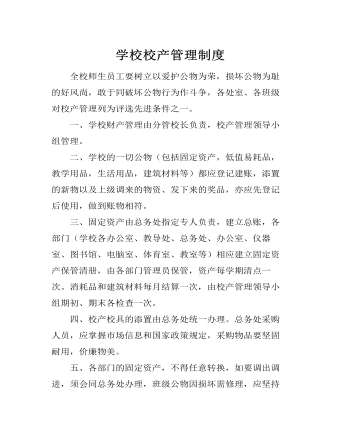
学校校产管理制度
二、学校的一切公物(包括固定资产,低值易耗品,教学用品,生活用品,建筑材料等)都应登记建账,添置的新物以及上级调来的物资、发下来的奖品,亦应先登记后使用,做到账物相符。 三、固定资产由总务处指定专人负责,建立总账,各部门(学校各办公室、教导处、总务处、办公室、仪器室、图书馆、电脑室、体育室、教室等)相应建立固定资产保管清册,由各部门管理员保管,资产每学期清点一次。消耗品和建筑材料每月结算一次,由校产管理领导小组期初、期末各检查一次。
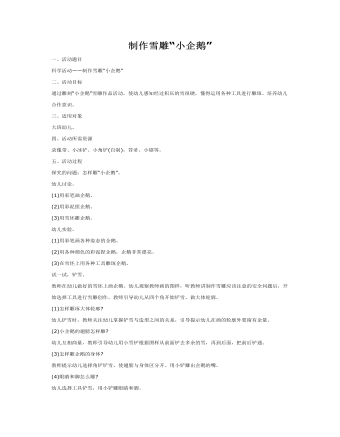
大班科学教案:制作雪雕“小企鹅”
二、活动目标通过雕刻“小企鹅”雪雕作品活动,使幼儿感知经过积压的雪很硬,懂得运用各种工具进行雕琢。培养幼儿合作意识。三、适用对象大班幼儿。四、活动所需资源录像带、小冰铲、小角铲(自制),笤帚、小锯等。五、活动过程探究的问题:怎样雕“小企鹅”。幼儿讨论。(1)用彩笔画企鹅。(2)用彩泥捏企鹅。(3)用雪坯雕企鹅。
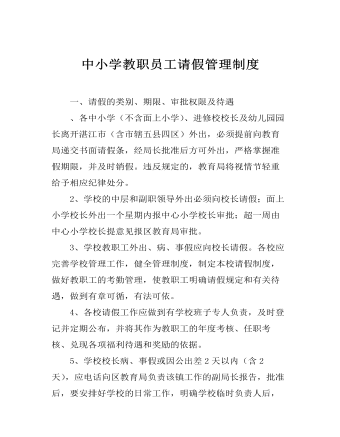
中小学教职员工请假管理制度
2、学校的中层和副职领导外出必须向校长请假;面上小学校长外出一个星期内报中心小学校长审批;超一周由中心小学校长提意见报区教育局审批。 3、学校教职工外出、病、事假应向校长请假。各校应完善学校管理工作,健全管理制度,制定本校请假制度,做好教职工的考勤管理,使教职工明确请假规定和有关待遇,做到有章可循,有法可依。 4、各校请假工作应做到有学校班子专人负责,及时登记并定期公布,并将其作为教职工的年度考核、任职考核、兑现各项福利待遇和奖励的依据。
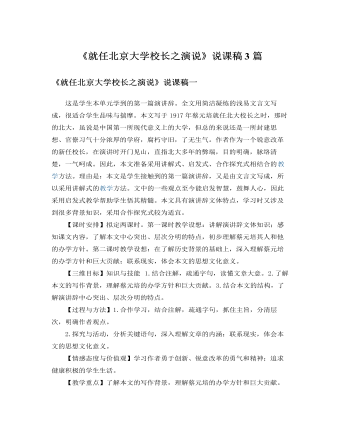
人教版高中语文必修2《就任北京大学校长之演说》说课稿3篇
(三)教学重、难点1、教学重点:结合课文,了解演讲辞针对性强、条理清楚、通俗易懂、适当的感情色彩等特点。2、教学难点:深入理解文章内涵,联系现实,体会本文的现实意义二、说学情高中学生在初中阶段已经接触过演讲辞了,对演讲词的特点已经有了一些基本的知识,因此本轮的教学应该让他们在此基础上有所提高。本文是学生在高中阶段第一次接触演讲辞,有必要让他们了解演讲辞的特点及课文如何体现这些特点的。随着年龄的增长,生活阅历的增加,高中学生正逐渐形成自己对世界、对人生的看法,蔡元培先生的这篇文章能很好地激发他们对当前的高中学习和未来的大学生活进行思考。此外,学生对北大的历史及蔡元培先生作这番演讲的时代背景了解不深,应作出补充说明。
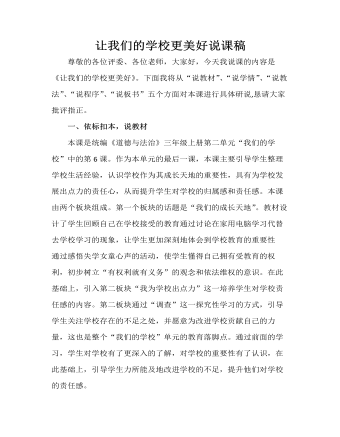
人教部编版道德与法制三年级上册让我们的学校更美好说课稿
过渡:你们是学校的小主人,学校的发展不仅需要你们出谋划策,更需要从身边的小事做起。你们能为学校做些什么呢? 一集思广益预设生:我们可以做爱护花草的小卫士。生:我应该保护校园里的展示牌。生:在图书馆看书,爱护书本,借后按时归还。……师:同学们出的主意真是各有各的好,只要大家说到做到,我们的校园一定会越来越美好。二绘制行动方案师:我们不仅要自己做到,还应该让更多的同学加入进来,请大家以小组为单位,把你们想的写下来。学生认真绘制行动方案,老师巡视,作品展示。贴为板书教师总结:在学校这方天地间,同学们收获了本领,拥有了友情,懂得了道理,比起那些上不了学的同龄人来说,你们真的太幸福了,希望同学们能够珍惜在学校里的每一天,过出属于自己的精彩!同学们用自己的聪明才智,总结出这么多帮助学校变得更好的方法,希望越来越多的同学能在你们的影响下,做好这一件件不起眼的小事,为我们的学校出点力!
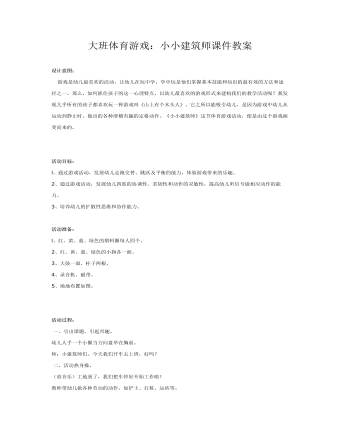
大班体育游戏:小小建筑师课件教案
活动目标:l、通过游戏活动,发展幼儿走跑交替、跳跃及平衡的能力,体验游戏带来的乐趣。2、通过游戏活动,发展幼儿四肢的协调性、柔韧性和动作的灵敏性,提高幼儿听信号做相应动作的能力。3、培养幼儿的扩散性思维和协作能力。 活动准备:l、红、黄、蓝、绿色的塑料圈每人四个。2、红、黄、蓝、绿色的小旗各一面。3、大鼓一面,柱子两根。4、录音机、磁带。5、场地布置如图。
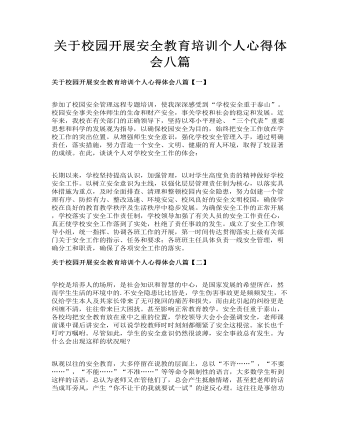
关于校园开展安全教育培训个人心得体会八篇
学校是培养人的场所,是社会知识和智慧的中心,是国家发展的希望所在,然而学生生活的环境中的.不安全隐患比比皆是,学生伤害事故更是频频发生,不仅给学生本人及其家长带来了无可挽回的痛苦和损失,而由此引起的纠纷更是纠缠不清,往往带来巨大困扰。甚至影响正常教育教学。安全责任重于泰山,各校均把安全教育放在重中之重的位置,学校领导大会小会强调安全,老师课前课中课后讲安全,可以说学校教师时时刻刻都绷紧了安全这根弦。家长也千叮咛万嘱咐。尽管如此,学生的安全意识仍然很淡薄,安全事故总有发生。为什么会出现这样的状况呢?
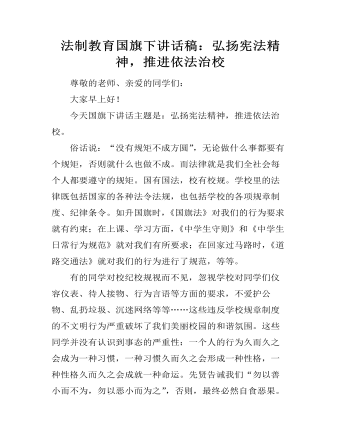
法制教育国旗下讲话稿:弘扬宪法精神,推进依法治校
尊敬的老师、亲爱的同学们:大家早上好!今天国旗下讲话主题是:弘扬宪法精神,推进依法治校。俗话说:“没有规矩不成方圆”,无论做什么事都要有个规矩,否则就什么也做不成。而法律就是我们全社会每个人都要遵守的规矩。国有国法,校有校规。学校里的法律既包括国家的各种法令法规,也包括学校的各项规章制度、纪律条令。如升国旗时,《国旗法》对我们的行为要求就有约束;在上课、学习方面,《中学生守则》和《中学生日常行为规范》就对我们有所要求;在回家过马路时,《道路交通法》就对我们的行为进行了规范,等等。
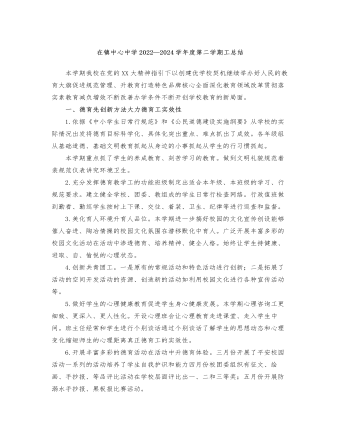
在镇中心中学2023—2024学年度第二学期工作总结
3.本学期我校还举行了新团员入团仪式。一批新团员庄严的举起右手宣誓成XX镇中心初级中学的一批新团员。五、总后勤工方面在本学期的教育教学工中总工在工中坚持发挥后盾用本着以教书育人育人教学的原则坚持履行学校的整体工步骤切实完成好学校的总后勤工。1.在后勤工中本着教学的识着力强化后勤队伍建设努力增强识。2.严格履行财制度规范财行。在经费使用方面执行预算审批制度在购物方面实行采购审批和政府采购制度杜了各种不正之风证了资金的效益最大化。3.学校和各班班主任签定了班班通责任书强了班班通设备管理。同时制定了《班级财产管理制度》把公物管理列入班主任考核内容之一强了财产管理。总之经过一学期全体师生的共同努力我们取得了一定的成绩但也有着不少的问题。我们学校的发展还需全体教职员工精诚团结继续发扬艰苦奋斗的精神我校可持续发展继续努力。
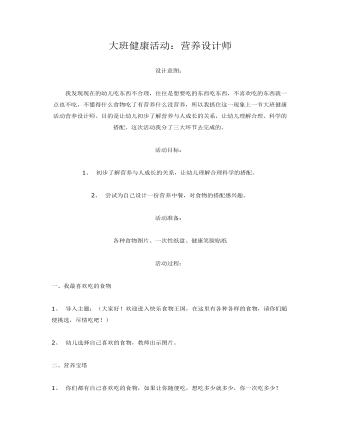
大班健康活动:营养设计师教案
活动目标:1、 初步了解营养与人成长的关系,让幼儿理解合理科学的搭配。2、 尝试为自己设计一份营养中餐,对食物的搭配感兴趣。活动准备:各种食物图片、一次性纸盘、健康笑脸贴纸活动过程:
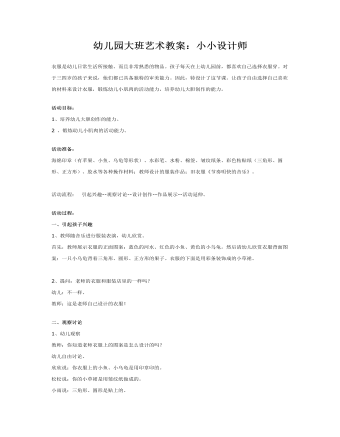
幼儿园大班艺术教案:小小设计师
活动目标: 1、培养幼儿大胆创作的能力。 2 、锻炼幼儿小肌肉的活动能力。 活动准备: 海绵印章(有苹果、小鱼、乌龟等形状)、水彩笔、水粉、棉签、皱纹纸条、彩色粘贴纸(三角形、圆形、正方形)、胶水等各种操作材料;教师设计的服装作品;旧衣服《节奏明快的音乐》。 活动流程: 引起兴趣--观察讨论--设计创作--作品展示--活动延伸。 活动过程: 一、引起孩子兴趣 1、教师随音乐进行服装表演,幼儿欣赏。 首先,教师展示衣服的正面图案:蓝色的河水、红色的小鱼、黄色的小乌龟。然后请幼儿欣赏衣服背面图案:一只小乌龟背着三角形、圆形、正方形的果子。衣服的下面是用彩条装饰成的小草裙。 2、提问:老师的衣服和服装店里的一样吗? 幼儿:不一样。 教师:这是老师自己设计的衣服!
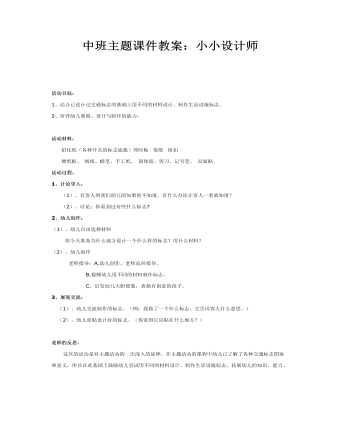
中班主题课件教案:小小设计师
2、培养幼儿观察、设计与制作的能力。 活动材料: 铅化纸(各种开关的标志底板)即时贴 皱纸 纽扣 硬纸板、绒线、蜡笔、手工纸、固体胶、剪刀、记号笔、双面贴活动过程:1、计论导入: (1)、有客人到我们幼儿园如果他不知道,有什么办法让客人一看就知道? (2)、讨论:你看到过有些什么标志?2、幼儿创作:(1)、幼儿自由选择材料 你今天准备为什么地方设计一个什么样的标志?用什么材料?(2)、幼儿创作 老师指导:A.幼儿创作,老师巡回指导。 B.提醒幼儿用不同的材料制作标志。 C.启发幼儿大胆想象,表扬有创意的孩子。
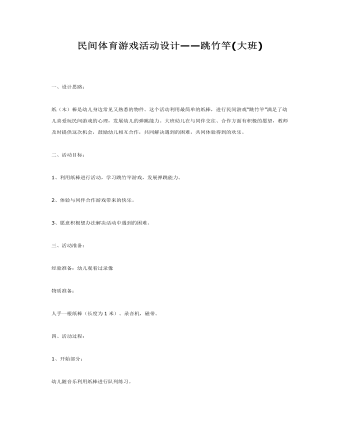
大班体育教案:民间体育游戏活动设计—跳竹竿
二、活动目标:1、利用纸棒进行活动,学习跳竹竿游戏,发展弹跳能力。2、体验与同伴合作游戏带来的快乐。3、愿意积极想办法解决活动中遇到的困难。三、活动准备:经验准备:幼儿观看过录像物质准备:人手一根纸棒(长度为1米)。录音机,磁带。四、活动过程:1、开始部分:幼儿随音乐利用纸棒进行队列练习。导语:今天天气真不错,我们骑着马出去玩玩吧!(幼儿随音乐的变化“骑马”变双圆----大圆----小圆---- “坐马车” )反思:活动开始部分设计了随音乐利用纸棒进行队列练习在这一环节中由两队“骑马”变双圆----变小圆----合作组合“坐马车”体现了动静交替的原则,让幼儿初步尝试了与同伴合作的快乐,同时也为下一个环节奠定了基础。2、基本部分:(1)利用纸棒进行“一棒多玩”导语:纸棒可以和我们玩坐马车的游戏,还可以和我们玩什么游戏呢?我们一起来试试,可以自己玩,也可以和小伙伴一起玩。(幼儿四散游戏)队形:两路纵队(见附图)(2)学习“跳竹竿”游戏A、讲解游戏玩法导语:刚才小朋友用纸棒玩了许多游戏,今天老师要和大家用纸棒玩一个新游戏——跳竹竿,这个游戏可以三个或四个小朋友一起玩,其中两个小朋友手拿竹竿面对面跪下,用竹竿同时分合敲击,另一个小朋友在中间看准竹竿的分合跳进或跳出。大家可以自己选择小伙伴一起试一试。队形:梯形队(见附图)(3)幼儿自由组合尝试玩“跳竹竿”游戏队形:四散(4)对幼儿在游戏过程中出现的情况及时进行指导(合作、交往方面)导语:你刚才和谁一起玩的?你们是怎么跳竹竿的?队形:梯形队(见附图)(5)鼓励幼儿创造性地玩“跳竹竿”游戏,师生共同参与。

学习优秀十佳教师事迹心得体会八篇
一、明确了阅读教学的方向,即课堂上要注重阅读教学的实效性。 多位专家老师都提到阅读教学要吃准目标,以课程标准为依据制定教学目标,以学生发展为本,使学生养成好的习惯,爱语文,爱阅读,有读书看报的习惯。这就要求教师要与内容分析式的语文课堂说再见,注重语文的工具性,要让教学真正服务于学生,使学生做到真读、真说、真写、真思考、真体验。关于教学目标,要做到“心中有标”(有课标、有教学目标)、“目中有人”(教师目中要有学生)、“心中有材”(心中装着教材),教学目标很重要,教师对每一课教学目标要明确,目标要定得准。目标确定后,整个教学设计就要围绕目标来进行,教学环节要体现目标,要围绕目标来实施,课堂上设计的问题要为目标服务,跟教学目标无关的不要设计。也就是说,课堂上我们该教的就教,不该教的坚决不教,我们的课堂也许就会变得简约、简朴、高效了


